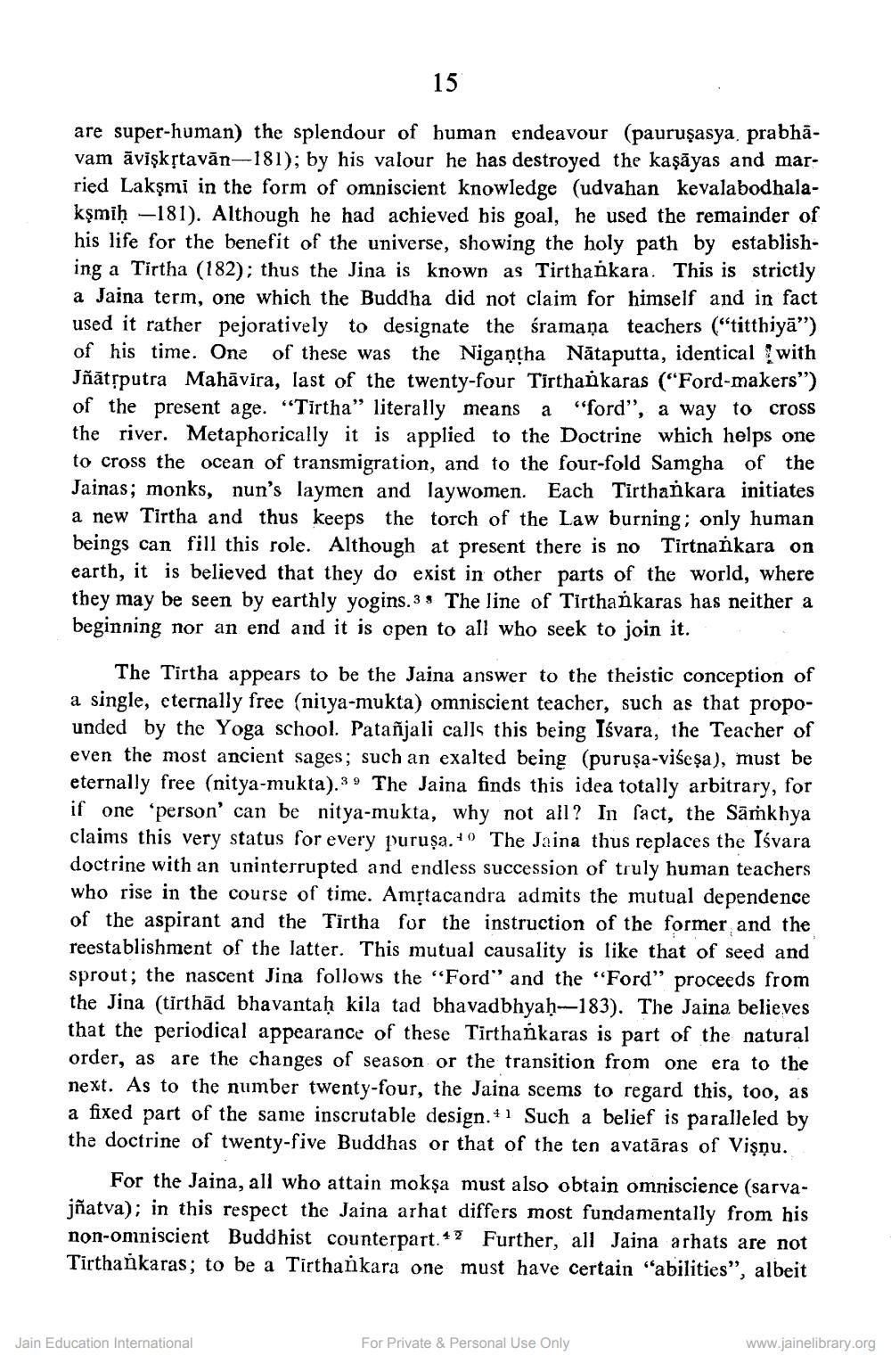________________
15
are super-human) the splendour of human endeavour (pauruşasya, prabhāvam āviskstavān-181); by his valour he has destroyed the kaşāyas and married Lakşmi in the form of omniscient knowledge (udvahan kevalabodhalakşmih -181). Although he had achieved his goal, he used the remainder of his life for the benefit of the universe, showing the holy path by establishing a Tirtha (182); thus the Jina is known as Tirthankara. This is strictly a Jaina term, one which the Buddha did not claim for himself and in fact used it rather pejoratively to designate the śramaņa teachers ("titthiyā'') of his time. One of these was the Nigantha Nätaputta, identical with Jñātņputra Mahāvira, last of the twenty-four Tirthankaras ("Ford-makers"') of the present age. “Tirtha" literally means a "ford", a way to cross the river. Metaphorically it is applied to the Doctrine which helps one to cross the ocean of transmigration, and to the four-fold Samgha of the Jainas; monks, nun's laymen and laywomen. Each Tirthařka a new Tirtha and thus keeps the torch of the Law burning; only human beings can fill this role. Although at present there is no Tirtnankara on earth, it is believed that they do exist in other parts of the world, where they may be seen by earthly yogins.38 The line of Tirthańkaras has neither a beginning nor an end and it is open to all who seek to join it.
The Tirtha appears to be the Jaina answer to the theistic conception of a single, eternally free (niiya-mukta) omniscient teacher, such as that propounded by the Yoga school. Patañjali calls this being Isvara, the Teacher of even the most ancient sages; such an exalted being (puruşa-višeşa), must be eternally free (nitya-mukta).3 9 The Jaina finds this idea totally arbitrary, for if one person can be nitya-mukta, why not all? In fact, the Sāṁkhya claims this very status for every puruṣa. 19 The Jaina thus replaces the Isvara doctrine with an uninterrupted and endless succession of truly human teachers who rise in the course of time. Amộtacandra admits the mutual dependence of the aspirant and the Tirtha for the instruction of the former and the reestablishment of the latter. This mutual causality is like that of seed and sprout; the nascent Jina follows the "Ford" and the “Ford” proceeds from the Jina (tirthad bhavantaḥ kila tad bhavadbhyah--183). The Jaina believes that the periodical appearance of these Tirthańkaras is part of the natural order, as are the changes of season or the transition from one era to the next. As to the number twenty-four, the Jaina seems to regard this, too, as a fixed part of the same inscrutable design. #1 Such a belief is paralleled by the doctrine of twenty-five Buddhas or that of the ten avatāras of Vişnu.
For the Jaina, all who attain mokṣa must also obtain omniscience (sarvajñatva); in this respect the Jaina arhat differs most fundamentally from his non-omniscient Buddhist counterpart.42 Further, all Jaina arhats are not Tirthankaras; to be a Tirthankara one must have certain "abilities", albeit
Jain Education International
For Private & Personal Use Only
www.jainelibrary.org




